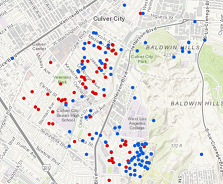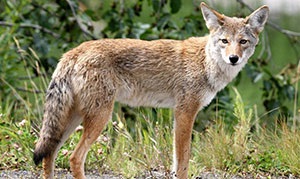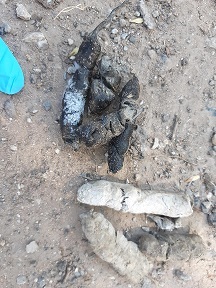Subscribe to coyote management email notifications.
Coyotes are present in Culver City and throughout Southern California. Although they generally avoid human contact, coyotes are wild animals. Coyotes have killed unattended small pets in Culver City. The City monitors residents’ reports of coyote behavior in consultation with wildlife experts, and the City will take appropriate action to protect human safety. It is especially important that the City be notified of any aggressive coyote behavior towards humans.

In 2019, the City Council approved a three-year Culver City Coyote Study and Management Program, which is led by Dr. Eric G. Strauss, PhD from the Loyola Marymount University/Los Angeles's Center for Urban Resilience. Dr. Strauss's work began on July 1, 2019. The final City of Culver City Coyote Report was completed in September 2022(PDF, 4MB). On March 13, 2023, Dr. Strauss and his team provided a presentation to the City Council about their findings, which included an overview of the Coyote Management Report(PDF, 498KB).
Join from the meeting link.
Join by meeting number.
Meeting number (access code): 2488 156 9831
Meeting password: Sij47MYfRm3
Tap to join from a mobile device.
Join by phone.
As part of the effort to adopt effective solutions, regarding coyotes and their management. As part of the LMU-LACures research, the public completed an online survey, regarding coyotes and their management.
Online Mapping Tool
The first year of the multi-year study includes, in its suite of activities, a review and assessment the City's existing data relating to coyote distribution and activity. Dr. Strauss's team has developed an online data visualization tool to depict a collection of community sightings and encounters with coyotes our area from 2013 to the present. The public is invited to view the online mapping tool.
Reporting Coyote Sightings or Activity
If you are in immediate danger, or fear for your safety or the safety of others, dial 9-1-1.
Be your neighborhood's eyes and ears and help maintain a safe community by immediately reporting any coyote presence or activity to the City:
 In recent years, Culver City, along with other Southern California cities, has begun to experience an increase in the amount of coyote encounters. These encounters include numerous attacks on pets that were off leash, unattended in residential backyards, and an upsurge in sightings in areas populated by people.
In recent years, Culver City, along with other Southern California cities, has begun to experience an increase in the amount of coyote encounters. These encounters include numerous attacks on pets that were off leash, unattended in residential backyards, and an upsurge in sightings in areas populated by people.
Historically, coyotes have existed in and around Culver City, finding safe haven in areas including the Oil Fields backing Blair Hills, the Culver City Park and the Culver City Crest Neighborhood. Additionally, other areas within the City where dense brush is prevalent (hill sides, areas in and around the Ballona creek, etc.) also provide spots where coyotes can safely build dens and reproduce. It is also believed that the prolonged drought has limited potential food sources for the coyotes and thus drawn the coyotes to residential neighborhoods in search of food and water.
In general, coyotes regularly roam an area of about 2-5 square miles or whatever it takes to get enough food for the pack members. Normally, each coyote family group is a territorial and varies in number from 3 to 10 individuals. Coyotes are opportunistic, versatile carnivores that primarily eat small mammals, such as rabbits, ground squirrels, and mice. Coyotes tend to prefer fresh meat but will eat significant amounts of fruits and vegetables during the autumn and winter months when their prey is scarce. Part of the coyotes’ success as a species is its dietary adaptability. This dietary flexibility, coupled with a lack of prey and closer proximity to residents, has led the coyotes to seek alternative food sources, including small pets, pet food, and fallen fruits and vegetables found in the backyards of homes.
The mission of Culver City Animal Services is to protect the health, safety and general welfare of the Culver City residents and animals through effective and courteous enforcement and education of the Culver City Municipal Codes, Los Angeles County Codes, California Code of Regulations Title 14 and state laws. Culver City Animal Services encourages the healthy retraining of the public and of the natural wildlife.
The City of Culver City has developed a comprehensive Coyote Management Plan(PDF, 669KB). The City has established new reporting mechanisms that will ensure a swift response to any aggressive coyote behaviors towards humans.
Coyotes are usually wary of people and will avoid us whenever possible. Bold behavior is unusual and is most often a result of habituation due to intentional or unintentional feeding, the presence of a dog or cat, or the coyote defending a den and young. The abundance of food, water and shelter offered by urban landscapes can lead to conflicts.
There are preventative measures that both residents and businesses can take to reduce the presence of coyotes in our community:
- Show your pets you love them by never leaving them unattended outdoors.
- Do not leave small children unattended outdoors.
- Do not feed or leave out food for local wildlife (ie., raccoons, opossum, outdoor cats).
- Keep your property clear of fruit droppings and secure refuse containers(PDF, 154KB).
- Cover and/or seal off any outside water sources
- Clean up messy bird feeders or spilled birdseed.
- Clean up, cover and/or seal off compost piles.
- Secure or store garbage bins in enclosed structures or securely strap down lids.
- Cats should be kept indoors at all times and dogs should be walked on a leash, not exceeding six feet in length.
- Block "crawl space" access under decks, houses, storage sheds and containers
- Consider using motion lights when possible to alert you to activity outdoors
Coyote hazing simply means scaring a coyote away from you, your yard, or your neighborhood. Coyotes are members of the dog family--just as we train our dogs to adopt good behavior, we can reinforce a coyote’s natural instinct to avoid people without harming them. Hazing involves asserting yourself by reacting to the inappropriate presence of a coyote so that it is frightened or startled and leaves the area.
The following information on hazing is very similar to what the L.A. Sheriff's Department, City of L.A. Department of Animal Services, and the California Department of Fish and Wildlife have shared on their websites and social media sites:
View coyote Hazing tips and techniques.(PDF, 534KB)
Hazing Techniques:
- Yelling and waving arms
- Responding aggressively
- Banging pots and pans
- Using squirt guns or garden hoses
- Throwing tennis balls or rocks
- Utilizing whistles or air horns
Hazing Tips:
- Stand your ground. Make eye contact and do not run away. Advance toward the coyote with your hazing tools (such as pans, water squirt gun, umbrella, can with coins) if there is hesitation on the part of the coyote.
- Make sure the coyote is focused on you as the source of danger or discomfort. Do not haze from buildings or your car where the coyote can’t see you clearly.
- Make it multi-sensory. Use tools that scare with sound, light and/or motion.
- Variety is essential. Coyotes can learn to recognize and avoid individual people, so the more often a coyote has a negative experience with various hazing tool and different people, the faster he will change his behavior to avoid human contact.
- Hazing should be exaggerated, assertive, and consistent. Communities should always maintain some level of hazing using a variety of tools so that the coyotes do not return to unacceptable behavior over time.
Wildlife Watch is a partnership program in which the community and city departments work to establish a comprehensive and integrated management strategy for minimizing human-wildlife conflicts and improving the quality of life in urban settings. Residents are participating in Wildlife Watch in order to reduce the number of coyote encounters and keep neighborhoods safe. Email Leon Lopez to join the Wildlife Watch program.
 What are coyotes eating? Reports coming out of different cities vary dramatically. Why is that? Because many surveys of coyote diet come from places where their scat (the fancy word for poop) is easy to find, like parks and preserved nature trails.
What are coyotes eating? Reports coming out of different cities vary dramatically. Why is that? Because many surveys of coyote diet come from places where their scat (the fancy word for poop) is easy to find, like parks and preserved nature trails.
How do you know? Well, it is similar in size to a large dog’s poop, but it will be grayish or blackish in color, have lots of hair and possibly bone in it, and be tapered at the ends. Dog poop will typically be brownish in color with bits of yellow and rounded at the ends. Coyote poop also closely resembles opossum poop, which you are also likely to find in your yard. They are similar in size and color, but opossum is usually darker, doesn’t have tapered ends and will contain more small berries and seeds.
Dietary analysis was a key component of this study, because it allowed researchers to identify what coyotes are preying on and also identified through DNA analysis, which individual coyotes are eating what. This information helped to figure out how many coyotes are preying on your cats and target those individuals specifically in our management plan. Researchers provided a summary of coyote scat in Culver City in their September 2022 report.
I’ve lived in Culver City my whole life and have never heard about coyote problems. Why now?
There could be lots of reasons for this. Urban areas continue to expand into wild areas, reducing land available for use by animals and increasing the opportunity for humans to interact with wildlife. In Los Angeles, it likely has to do with a previous decade of record droughts that have affected plants, and therefore, prey species of the coyotes. As they have fewer prey in their natural areas, they are forced to venture into neighborhoods looking for food.
Here, they find all the resources we provide, such as trash, pet food, fruit, and outdoor pets. We also often have water sources in our yards for decoration. Once coyotes discover the multiple food and water sources, they will continue to visit, increasing the odds they will come in contact with us or our pets.
Where are they coming from?
Researchers aren’t yet sure where the coyotes are coming from, but they know where some are living: in the oil fields, parks, cemeteries and other large properties surrounding Baldwin Hills.
Once researchers start radio tracking individual coyotes, they will have a better idea of their territory. Because coyotes can travel up to 25 miles in a night, Culver City may have resident coyotes and transient coyotes who are just traveling through our community.
How many coyotes does Culver City have?
Researchers are still learning this through The Culver City Coyote Study and Management Program.
Urban coyotes have smaller territory sizes than those occupying natural areas, so they may exist in areas as small as two square miles. Coyotes don’t travel in large packs, like wolves do, but often have just one alpha pair and two to four juveniles, many of which will travel on their own once they are old enough.
My yard is fenced. I don’t have to worry about coyotes, do I?
Yes. Coyotes can easily jump a six-foot fence to get in your yard. In addition, they can crawl under your fence through very small openings that might, at first, seem impossible (until they make their way through).
What do coyotes eat?
Coyotes are opportunistic, so they’ll eat almost anything. A recent study by the National Park Service showed that urban coyotes get 75% of their food from human sources. This includes unsecured trash, pet food (for outdoor pets), cats, and fallen fruits and vegetables–especially citrus plants and figs–found in the backyards of homes.
If you have these trees in your yard, make sure to pick up fruit that will attract coyotes(PDF, 154KB).
What should I do if I see one?
Many times, our instinct is to get away from a wild animal, but the best way for coyotes and humans to co-exist is for them to fear us.
When you see one, if it is safe to do so, get as large by making noise, appearing threatening, and even throwing objects at them. NEVER do this to an animal that is cornered, protecting its den, or appears injured. If you fear for your safety, find shelter. Never feed a wild animal. That animal may start approaching humans looking for food and get aggressive.
How do I know if a coyote is protecting a den?
Coyotes only den when they have young pups, and they will often stay very close to the den. They are very secretive, and dens often will not be visible. If a coyote is seen in one area repeatedly or seems reluctant to leave the area, it may be a den.
If you suspect a den, use the Dedicated Coyote Hotline at (310) 253-6141, email Animal Services, or use the Online Coyote Reporting Form. Do not investigate on your own. Coyotes can be very protective of their pups.
Why can’t we just get rid of them?
Coyotes have been in the United States longer than Europeans and have been very successful. Local, state, and federal government agencies have been trying to eradicate coyotes as long as they have tried with wolves. While these efforts were largely successful with wolves, coyote reproductive strategies and ability to co-exist with humans have made them impossible to remove. We kill more than 400,000 coyotes in the United States annually, and their population has not decreased. If one pack is removed from its territory, another pack or two will move into that territory.
A more effective strategy is to understand what we are doing to attract them to our neighborhoods, change our behavior, and remove selected individuals who we know to be targeting pets and humans.
Will a coyote attack a human?
Coyote attacks on humans are very rare. You are much more likely to be bitten by a dog. However, if a coyote is being fed by humans, injured, or protecting a den, it may try to bite a human.
What can I do?
The City of Culver City has partnered with Loyola Marymount University to understand its coyotes and develop an effective management plan. Gathering data is part of tailoring a plan that is right for Culver City. This study will help us understand how many coyotes are living in Culver City, where they live, and how they use our neighborhoods. It involves installing camera traps, radio-collaring both coyotes and feral cats, and using scat analysis to identify coyote diets.
Scientists at Loyola Marymount University are offering free backyard risk assessments to determine what characteristics of our yards are drawing coyotes to them. They are also installing backyard cameras to see how coyotes are utilizing our backyards. If you would like a backyard assessment or a camera in your yard, please email Dr. Melinda Weaver at melinda.weaver@lmu.edu for more information.
In addition, they are collecting scat samples (the fancy word for poop), so if you believe you have coyote scat in your backyard, contact Dr. Weaver.
Tips to protect your property and pets from coyotes:
- Secure all trash
- Remove standing water
- Feed your pets indoors
- Pick up fruit in your yard
- Keep pets indoors at night